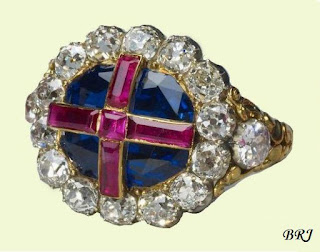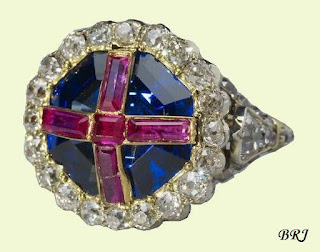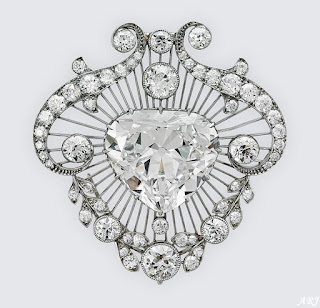A Coronation Ring has been part of British (and before
that, of English and Scottish) Coronation ceremonies for many centuries. With
few exceptions, each Sovereign received a new ring for his or her coronation to
symbolize their marriage to the nation. Since the 13th century it was
traditional to include a ruby as the principal stone in the ring.
During the ceremony, the ring is placed on the fourth
finger of the right hand by the Archbishop, as symbol of “kingly dignity”. In
earlier times, it was done after the crowning but before receiving the sceptre.
From William IV and onwards the
presentation of the ring preceded the anointing with holy oil and is followed
by the crowning itself.
 |
| Victoria's Coronation Ring (left), William IV's Coronation Ring (middle) and the Queen Consort's Coronation Ring (right) |
Currently, there are four rings called the Coronation
Rings in the British Royal Collection. The first one is the Stuart Coronation
Ring which was used before the Glorious Revolution: its first wearer was James
II, although it might have belonged earlier to Charles II and/or Charles I. The
second ring is the one that has been used most often –William IV Coronation
Ring: it was made for King William’s Coronation in 1831 and has been worn by
all subsequent Monarchs with the exception of Queen Victoria. The third ring is
Queen Victoria’s Coronation Ring; a new one had to be made for her because
William IV’s ring was way too large for her finger. The fourth ring is the
Queen Consort’s Ring was made for Queen Adelaide to be worn at her husband’s
coronation; all Queens Consort since Mary of Teck have worn the ring during
their respective husbands’ coronation ceremonies.
Now that we have a general idea of what the Coronation
Rings are, a more in-depth information about each ring.
The Stuart
Coronation Ring
The first known
wearer of the ring was James VII and II of Scotland and England for his
coronation in Westminster Abbey on 23 April 1685. In the account of the ceremony
the ring is described as a “plain gold ring with a large table ruby violet
wherein a plain cross, or cross of St. George, was curiously enchased”.
Before Queen Victoria left all the rings to the Crown, coronation rings were considered not Crown Regalia but personal property of the Sovereign who usually paid for the rings from their pockets. That may explain why the ring is absent from James VII and II’s coronation accounts which detailed money spent on each and every item used for the ceremony. Alternatively, it is possible the new King used Charles II’s ring. King Charles’ ring was also described as a gold ring with a ruby but no mention of a cross was made (it might have been added later). That ring was included in the warrant of 1660 for Coronation Regalia sent to the Master of the Jewel House but again, no payment for the ring is recorded to the royal goldsmith, nor did it appear in the list of items made for Charles II’s Coronation (and a lot of new items had to be made because most Crown Jewels were lost in the Revolution).
 |
| The Stuart Coronation Ring |
One possible
explanation for that omission is that the ring is even older and had actually
belonged to Charles I. In a letter dated January 1800, one Thomas Coutts
(Anglo-Scottish banker who founded the banking house of Coutts & Co.) wrote
how he had afforded his daughter the honour of putting on “the ring which Charles
I wore at his coronation”. That ring was undoubtedly the ring in possession of Cardinal
York and the same one used for the coronation of his grandfather, James II and
VII. Also supporting the theory Charles I’s ring was used is the fact it was
listed as “King Charles’s Coronation Ring” when it was listed at Windsor Castle
in 1830.
After the Glorious Revolution, the ring was among the
items James II took with him into exile in 1688. In 1715 it was included in an
inventory of possessions of his widow, Mary of Modena. Mary left the ring to
her grandson, Henry Benedict, Cardinal York who, in turn, bequeathed the ring to
the Prince of Wales in 1807: in his will, the ring is described as a “ruby ring
surrounded by brilliants. On the ruby a cross is engraved. It was used on the
coronation day of the Kings of Scotland”. It finally arrived back to England in
1815 and was presented to the Prince Regent at Carlton House in June of 1815. In
1830, William IV loaned the ring to be displayed with the Honours of Scotland
in Edinburgh Castle; there is no record of the ring being used after that.
The Stuart Ring is
made of gold, silver, ruby and diamonds. The flat-cut ruby is probably half of
a medieval bead. The border of brilliants is a later addition, most probably
commissioned by either James II or Mary of Modena; the setting was first
mentioned in the will of Cardinal York (James II’s grandson). In addition, it
was extensively remodelled for the Prince of Regent.
William IV’s
Coronation Ring
The largest of the rings was made of King William IV’s coronation in 1831 and has been used for every subsequent coronation except Queen Victoria's.
King William departed slightly from tradition; as mentioned earlier, since the 13th century, the main stone has always been ruby. While William IV’s Coronation Ring does contain rubies (forming the cross), the main stone is a sapphire.
 |
| King William's Coronation Ring |
As the ring was his personal property, William IV left it
to his wife, Queen Adelaide. The Queen, however, felt that the ring was a crown
property so she gave it, along with her own coronation ring, to Queen Victoria.
The ring consists
of an octagonal step-cut sapphire, open-set in gold, overlaid with four oblong
and one square rubies in gold strips forming the cross of St. George, within a border of twenty cushion-shaped
brilliants in transparent silver collets. Brilliants decorate the shank and
band.
Queen Victoria’s
Coronation Ring
Queen Victoria's ring was given to her by her mother, the Duchess of Kent; it is engraved with the words "Queen Victoria's Coronation Ring 1838". The ring was specially made for the young Queen because William IV’s large coronation ring kept slipping off her tiny fingers. It is almost an exact copy of William IV’s ring, just smaller in size.
The Duchess of Kent commissioned the royal goldsmiths of the time - Rundell, Bridge & Rundell – to create the brand new ring. Misunderstanding the instructions, they made the ring for the wrong finger of the Queen - thinking it should go on the little finger, not the ring finger. Consequently, it was way too small for her which created some difficulties during the coronation. The Archbishop of Canterbury had to literally force the ring onto her fourth finger.
 |
| Queen Victoria's Coronation Ring |
Taking off the
ring proved to be even more problematic; it took much effort and over an hour
(as well as a lot of iced water) to remove the ring after the ceremony. The
Queen complained of the pain in her journal: “I had the greatest difficulty to
take it off again, - which I at last did with great pain”. Coincidentally,
there is an old tradition that says the tighter the ring the longer the reign;
since Queen Victoria’s reign of 64 is the longest of any British, English or
Scottish Monarch, it certainly proved to be true for her.
Usually,
coronation rings (rather like wedding rings) remained the personal property and
each new Monarch had a new ring made for them. Queen Victoria broke the
tradition by leaving her ring, along with those of William IV and Queen
Adelaide, to the Crown. Since then, all Sovereigns have used William IV’s ring
for their coronations.
The Queen Consort’s
Coronation Ring
The Queen Consort’s ring was made for Queen Adelaide to be worn at her husband’s coronation in 1831. William IV’s own ring had slightly departed from tradition by featured a sapphire (and not a ruby) as the main stone; possibly to make up for that, Queen Adelaide’s ring featured one single large ruby.
 |
| The Queen Consort's Ring |
The Queen Consort’s
coronation is a very simple and short ceremony which takes place towards the
end of the King’s coronation. Since Queen Adelaide, all Queens Consort have
worn her ring for their ceremonies. Although the ring was her personal
property, Adelaide felt it would be proper to give them to the new Queen, which
she duly did, along with William IV’s Coronation Ring (left to her by her
husband). Queen Victoria, in turn, left all the Coronation Rings to the Crown.
Queen Adelaide's
ring consist of an extended octagonal mixed-cut ruby in a gold setting, within
a border of fourteen cushion-shaped brilliants set transparent in silver
collets. The gold shank is set with fourteen graduated mixed-cut rubies.










.jpg)















